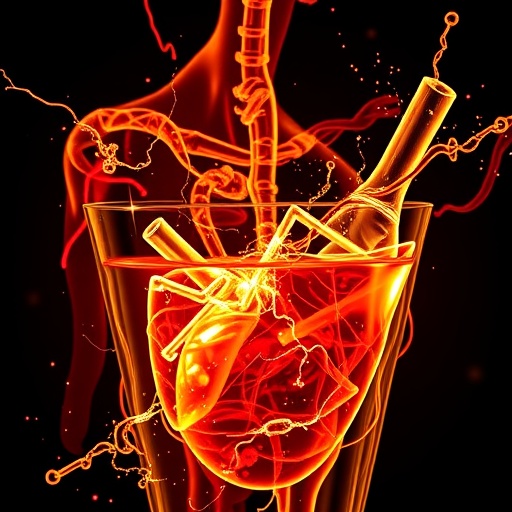In a striking advancement that underscores the profound impact of environmental toxins on male reproductive health, recent research has shed new light on the deleterious effects of Diazinon—a widely used organophosphate insecticide—on testicular function. The study, authored by Lee et al., presents compelling evidence that Diazinon exposure precipitates testicular dysfunction and induces significant cellular damage in murine models, effects predominantly mediated by an increase in reactive oxygen species (ROS) production. This revelation intensifies concerns about the pervasive use of organophosphates and their subtle yet profound biological consequences, suggesting an urgent need for re-evaluation of safety standards and exposure limits.
Diazinon, known for its broad-spectrum insecticidal properties, has historically been a double-edged sword in agricultural practices—effective in controlling pests yet increasingly implicated in human and animal health risks. The current investigation dissects the molecular pathways intimated in the testicular toxicity of Diazinon, with a particular focus on oxidative stress mechanisms. Oxidative stress, characterized by an imbalance between the generation of reactive oxygen species and the capacity of antioxidant defenses, emerges here as the pivotal mediator of cellular injury within testicular tissues.
The experimental framework underpinning these findings involved meticulously controlled exposures of mice to environmentally relevant concentrations of Diazinon, enabling observation of biochemical and histopathological changes over time. Detailed analyses revealed that Diazinon incites a surge in reactive oxygen species within testicular cells, overwhelming intrinsic antioxidant systems and culminating in oxidative damage to DNA, lipids, and proteins. This oxidative insult disrupts the homeostasis critical to spermatogenesis and steroidogenesis, precipitating notable declines in sperm quality and testosterone production.
A salient aspect of the study is the characterization of mitochondrial impairment following Diazinon exposure. Mitochondria, the cellular powerhouses intricately involved in energy metabolism and ROS regulation, exhibited marked dysfunction, characterized by depolarization of the mitochondrial membrane potential and release of pro-apoptotic factors. This mitochondrial derangement conspicuously contributes to the activation of intrinsic apoptotic pathways, ultimately promoting germ cell death and testicular atrophy.
Moreover, Lee and colleagues delved into the alterations of testicular histology, utilizing advanced imaging and staining techniques to elucidate the pathological changes at a cellular level. Disruptions in the seminiferous tubules—with evident disorganization and degeneration of Sertoli and Leydig cells—were documented. Such microarchitectural damage underscores the multifaceted nature of Diazinon toxicity, extending beyond oxidative stress and encompassing structural compromise.
The study also interrogated the inflammatory milieu within the testicular microenvironment. Oxidative stress is intricately linked to the activation of pro-inflammatory cytokine cascades, and indeed, the researchers observed elevated expression of interleukins and tumor necrosis factor-alpha, compounding cellular distress and fostering a local environment inimical to spermatogenic processes.
Importantly, the research highlights the dose-dependent dynamics of Diazinon toxicity, signaling that even sub-chronic exposures may precipitate significant biological dysfunction. This finding bears considerable translational relevance, as it emphasizes the risk posed by cumulative low-dose exposures common in agricultural communities and occupational settings.
The broader implications of this research transcend murine models, raising critical public health considerations. Male infertility rates have been rising globally, and environmental toxicants like Diazinon may constitute underappreciated contributors to this trend. By elucidating the biochemical and cellular sequelae of Diazinon exposure, this study amplifies the imperative to monitor and regulate organophosphate use with an eye toward reproductive health.
Furthermore, this work invigorates discourse on the molecular intersections between environmental chemicals and endocrine disruption. The observed declines in testosterone levels and perturbations in Leydig cell function suggest that Diazinon may operate as an endocrine disruptor, adding complexity to its toxicity profile and necessitating comprehensive endocrine evaluations in future toxicological assessments.
Methodologically, the application of cutting-edge molecular assays, including assessments of oxidative biomarkers, mitochondrial function tests, and inflammatory cytokine quantifications, endowed the study with robust mechanistic insights. This multidimensional approach exemplifies the integration of toxicology with cellular biology, yielding a nuanced understanding of chemical-induced pathophysiology.
Concomitantly, this investigation sets a precedent for future research exploring the interplay between agricultural chemical exposure and male reproductive endpoints. The demonstrated pathways of oxidative stress and inflammation provide focused targets for subsequent studies aiming to delineate protective mechanisms and susceptibility factors.
In conclusion, the compelling findings presented by Lee et al. illuminate the insidious impact of Diazinon on testicular integrity, mediated principally through ROS overproduction and consequent cellular insult. This research not only advances scientific comprehension of organophosphate toxicity but also signals a clarion call to public health stakeholders to revisit pesticide usage policies and champion protective interventions.
As the scientific community grapples with the multifactorial causes underpinning declining male reproductive health, studies such as this underscore the critical need for interdisciplinary efforts to unravel environmental determinants and devise effective mitigative strategies. Protective measures, including stringent regulation, public education, and development of antioxidant-based therapies, emerge as essential pillars supporting reproductive health preservation in the face of pervasive chemical exposures.
This pivotal research poised to influence regulatory frameworks highlights an urgent necessity: balanced pest control strategies that safeguard agricultural productivity without compromising human health. Continued vigilance and innovation in this realm promise to shield future generations from the unseen toll of environmental toxicants like Diazinon.
Subject of Research: Testicular dysfunction and cellular damage induced by Diazinon exposure mediated through increased reactive oxygen species production in mice
Article Title: Correction: Diazinon induces testicular dysfunction and testicular cell damage through increased reactive oxygen species production in mouse
Article References: Lee, R., Lee, WY., Kim, DW. et al. Correction: Diazinon induces testicular dysfunction and testicular cell damage through increased reactive oxygen species production in mouse. Cell Death Discov. 11, 233 (2025). https://doi.org/10.1038/s41420-025-02520-x
Image Credits: AI Generated
Tags: agricultural chemical exposure riskscellular damage from pesticidesDiazinon exposure limitsDiazinon testicular toxicityenvironmental toxins and healthmale reproductive health impactsorganophosphate insecticides effectsoxidative stress and male reproductionreactive oxygen species in testisresearch on pesticide toxicitysafety standards for pesticidestesticular dysfunction in mice





